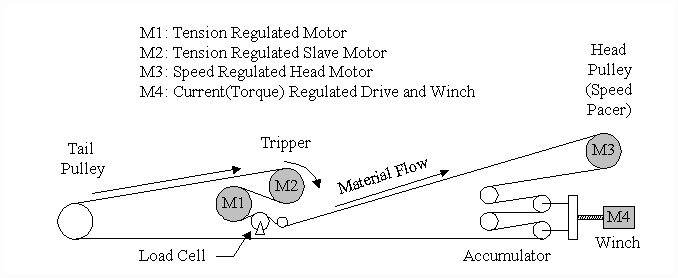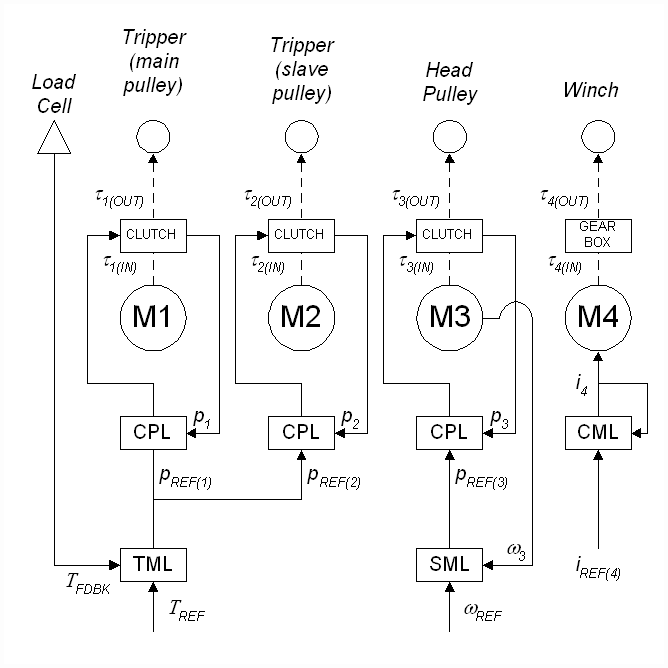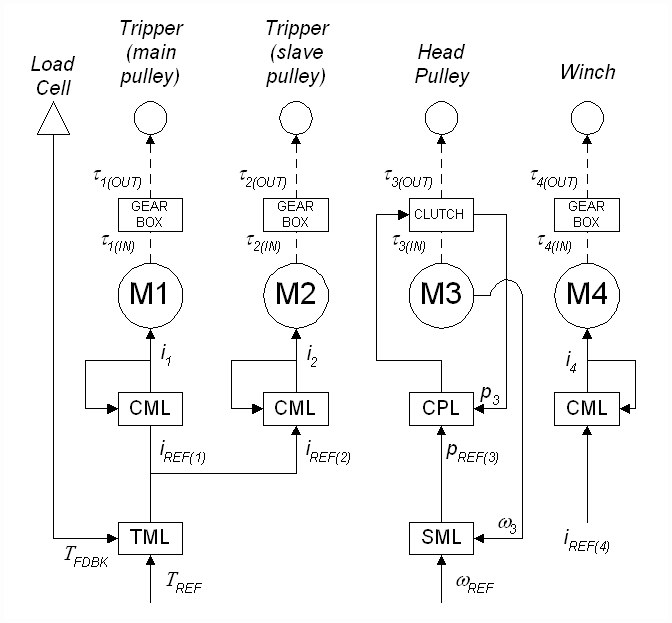PAPER No. 5 SUMMARY
Tripper Assisted Belt-Conveyor Tension Regulation (Mining Engineering Applications)
1997 AISE Annual Meeting
Brian Thomas Boulter
Applied Industrial Control Solutions LLC
4597 E Sprague Rd.
Independence, OH, USA 44131
© ApICS ® LLC 2000
Abstract - Long portable conveyors used in underground mining applications are currently configured with clutch-type secondary pulleys (trippers) that compensate for tension losses in the conveyor line. To increase the profitability of mining operations it is desirable to increase the length of the mining seams and hence the conveyors. However, as the conveyor length increases the tripper clutch size and cost become prohibitive. To dissipate the absorbed regenerative energy that arises when regulating belt tension, larger clutches require cooling with water or oil cooling systems. Given that the infrastructure required to support such cooling systems is itself expensive and difficult to move the use of active tension regulation with AC or DC drives, which require only an electric feed and are relatively inexpensive and easy to move, provide a cost effective solution. To this point the use of active tension regulation has been avoided due to stability problems associated with the tension regulator. This paper outlines a regulation scheme that addresses these problems and paves the way for cost effective underground mining conveyor solutions using AC drives or DC drives.
1. INTRODUCTION
Underground mining operations utilize portable conveyors to move material from active mining seams to a central material handling facility. The conveyors must be easily assembled and disassembled to facilitate quick turn around times when moving operations from a depleted seam to a fresh seam. To improve mine productivity, seam lengths and tonnage rates are increasing. Site engineering managers, in their search for cost effective material handling solutions, are specifying longer conveyors, higher material tonnage rates and lower material handling energy costs. As will be shown in later discussion, a cost effective solution for conveyor belt-tension regulation can be achieved using active AC or DC drives rather than passive clutch-based designs. Following is a short description of the typical tripper assisted mining conveyor.

Figure 1. Single Tripper Assisted Conveyors
Tripper assisted underground mining conveyor control systems with a single tripper consist of a belt used to convey the material, a head pulley with a speed regulated head drive, a secondary pulley (tripper) with a tension regulated secondary drive, a winch driven accumulator, and a tail pulley (Figure 1).
The head pulley sets the conveyor speed and is usually configured as an AC motor that is directly connected to the AC feeder mains. The motor is sized to rotate at top speed at an armature voltage slightly below the feeder line voltage. A mechanical clutch is used to ramp-up the conveyor translational speed to match the AC motor rotational speed. Speed control is accomplished by a closed speed loop (SML) that provides a trim reference (PREF) to the clutch pressure loop (CPL). The CPL may be operated as an open or a closed pressure loop depending on the O.E.M. clutch configuration. The secondary pulley (or tripper) is usually configured as an AC motor that operates in much the same way as the speed regulated pulley with the exception that the trim reference to the clutch pressure loop is provided by a closed tension loop (TML) with feedback from a load cell, similar to that shown in Figure 1. The Accumulator is used to store and release conveyor belt as needed as the tail pulley is moved along the seam that is being mined. The winch is typically driven by an AC or DC motor that is configured as an open loop current or torque regulator (CML). The current or torque reference is set to provide a desired belt tension at or near the head pulley. The tail pulley is not driven but is designed to be easily moved as mining operations move along the active seam.

Figure 2. Single-Line Diagram of the Clutch Tension-Regulated Mining Conveyor.
The tension regulated clutch of the tripper is always in a state of slip and, as a result, heat is constantly generated in the clutch assembly. As described above, a cooling system must be installed on trippers with sufficiently high loads. If a DC or AC drive can be used, the regenerative energy that results from regulating belt tension can be put back into the electric feeder mains as electric energy instead of into the mine shaft environment as heat energy. Figure 3 presents a single-line diagram of the proposed scheme.

Figure 3. Single-Line Diagram of the Drive Tension-Regulated Mining Conveyor.
The tripper CML’s must be designed with regenerative power units to allow for an energy flow from the motor to the feeder mains. Significant energy savings and more responsive tension regulation can be realized with this control topology if the tension regulator is designed with a stable and responsive closed tension loop.
Implementing the tension regulator shown in the architecture described in Figure 3 with a PI only regulator will invariably result in an unstable or extremely de-tuned tension loop. The PI regulator by itself cannot adequately compensate for extremely low frequency damped plant resonances such as those that occur in conveyor applications. A regulation scheme that adequately compensates for the low frequency damped poles and provides a significant improvement in tension regulation as well as significant reduction in energy costs is presented in section 3.
In Section 2, a simple linear model of the conveyor is developed and analyzed. Transfer functions are developed that provide a good approximation of the plant as seen by the tension regulator. These transfer functions provide the basis for determining the regulator structure in section 3. In Section 4 a brief energy analysis that provides a clear energy cost comparison between the current and proposed schemes is presented. Section 5 closes with some concluding observations and remarks.
4. ENERGY COST ANALYSIS
The use of regenerative drives in the tripper can result in significant energy savings, The following analysis provides an enlightening perspective on the potential for energy cost reduction using active regulation with drives as opposed to passive regulation with clutches.
The relationship between the power that is to be regenerated in the tripper and the tension drop across the tripper is given in Equation (11).
 (11) (11)
The energy cost per-hour associated with wasting this energy in the form of heat is:
 (12) (12)
Assuming an efficiency rating of 85% in the regeneration process the energy savings can be approximated as:
 (13) (13)
Using typical values in Eq’s 11,12, and 13, (600 [ft/min] conveyor speed, motor base speed of 1150 [r.p.m], roll radius of 1.5 [ft], gear ratio of 16:1, energy cost of 0.5  2.5 [cents/kW hr]), assuming the conveyor down-time is 5%, and the average tension drop across the tripper is 20000 [lb], the net energy savings per year can be approximated as: 2.5 [cents/kW hr]), assuming the conveyor down-time is 5%, and the average tension drop across the tripper is 20000 [lb], the net energy savings per year can be approximated as:
 


In addition to the expected energy savings from regeneration, the cost of operating the tripper cooling system can be a significant energy cost (approximately 1k  5k [$/yr]). Additional cost reductions can be realized from the time saved when moving the tripper. These savings will depend on the disassembly/assembly-crew work-efficiency and could vary from 1 to 10 production days per year (or cost savings equivalent to as much as 3% of the mine operating profit). 5k [$/yr]). Additional cost reductions can be realized from the time saved when moving the tripper. These savings will depend on the disassembly/assembly-crew work-efficiency and could vary from 1 to 10 production days per year (or cost savings equivalent to as much as 3% of the mine operating profit).
An additional cost consideration must be made with respect to the drive technology used. If DC drives are used, regeneration is straight forward and is accomplished with the use of a 12 or 24 diode power-module with bridge-reversing capabilities. The use of AC drive technology will require two inverters and an interim DC buss. The initial cost of the AC solution is therefore higher than the DC solution. The main advantage that is realized when employing the AC solution is that the AC motor does not require brush maintenance and the frame sizes are smaller resulting in a reduction in the expense of the motor.
5. CONCLUSIONS
In long conveyor applications that employ trippers, AC and/or DC static drives can provide a cost effective solution for regulating tension, if a stable tension regulator can be designed. The tension regulation scheme that is presented here-in has been shown in both simulation and field testing to provide a stable and responsive tension regulator architecture for these applications.
In the process of designing material handling solutions for mines, mining engineers should consider the cost benefits resulting from deploying AC/DC drives for tripper assisted conveyor belt tension regulation.

|